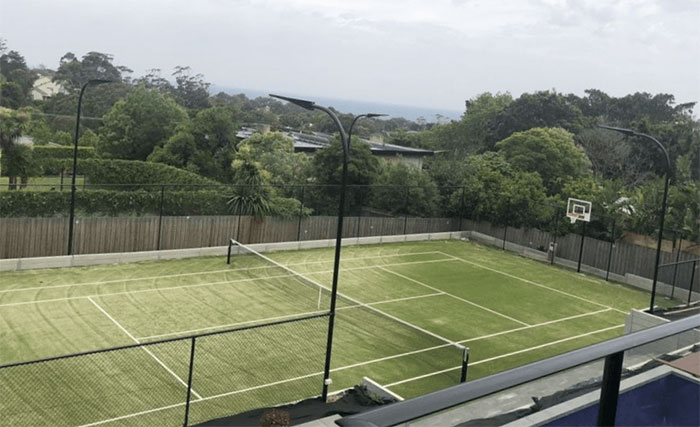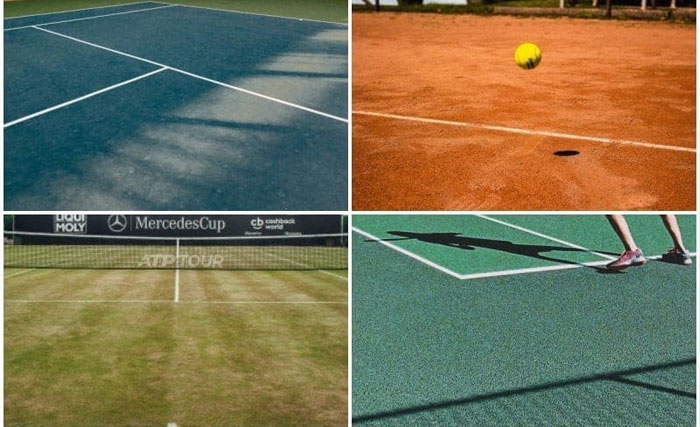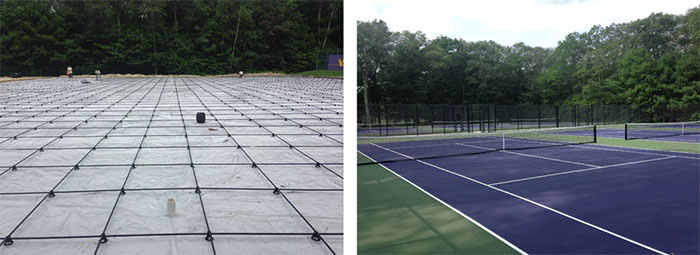Transforming dreams into the perfect match point starts with the precision of tennis court construction. In this article we talk about tennis court construction process.
Tennis court construction stages
Constructing a tennis court involves several stages, each of which is crucial to ensure the court is built to the required standards and specifications. Here are the typical stages involved in building a tennis court:
- Site Preparation:
- Clearing the area: Remove any vegetation, rocks, debris, or obstacles from the site.
- Leveling: Ensure the ground is flat and even to provide a stable base for the court.
- Layout and Marking:
- Marking out the court dimensions: Use measuring tools and string lines to mark the boundaries and lines of the court according to the official regulations.
- Verify dimensions: Double-check the measurements to ensure accuracy.
- Excavation:
- Digging: Excavate the area according to the marked dimensions, typically to a depth of around 12 inches (30 cm).
- Remove soil: Clear away excavated soil from the site.
- Base Construction:
- Installation of a gravel base: Lay down a layer of compacted gravel to provide a stable foundation for the court.
- Grading: Ensure the gravel base is properly graded to achieve the desired slope for drainage.
- Drainage Installation:
- Installation of drainage pipes: Lay perforated pipes along the edges of the court and connect them to a suitable drainage system to prevent water accumulation on the surface.
- Fencing and Surrounds:
- Installation of fencing: Erect fencing around the perimeter of the court for safety and security.
- Addition of surrounding features: Install any additional features such as windscreens, net posts, gates, or spectator seating as required.
- Surface Construction:
- Installation of the playing surface: Apply the chosen surface material, which could be asphalt, concrete, acrylic, or synthetic turf, according to the specified thickness and composition.
- Compaction and leveling: Compact the surface material to ensure uniformity and a smooth playing surface.
- Line Painting:
- Painting the court lines: Use durable paint to mark the boundary lines, service lines, center lines, and other court markings as per official regulations.
- Net Installation:
- Installation of the net: Erect the net posts and attach the net securely at the correct height and tension.
- Surface Finishing:
- Application of surface coatings: Apply any necessary coatings or sealants to enhance durability, traction, and weather resistance of the playing surface.
- Final Inspection and Testing:
- Inspection: Conduct a thorough inspection of the completed court to ensure it meets all specifications and standards.
- Testing: Test the surface for proper bounce, speed, and drainage performance.
- Handover and Maintenance Guidelines:
- Handover: Once the court passes inspection, hand it over to the owner or operator.
- Maintenance guidelines: Provide the owner with maintenance instructions and recommendations to ensure the court remains in optimal condition over time.
Tennis court dimensions
The dimensions of a standard tennis court, as defined by the International Tennis Federation (ITF), are as follows:
- Overall Court Size:
- For singles matches: 78 feet (23.77 meters) in length and 27 feet (8.23 meters) in width.
- For doubles matches: The width remains the same (27 feet or 8.23 meters), but the length increases to 78 feet (23.77 meters) for each side, resulting in a total length of 78 feet (23.77 meters) for each half of the court, separated by the net.
- Net Height:
- The net is suspended across the center of the court, dividing it into two equal halves.
- The top of the net is set at a height of 3 feet (0.914 meters) at the center and 3 feet 6 inches (1.07 meters) at the posts.
- Baseline:
- The baseline is the back boundary line of the court.
- It runs parallel to the net and is located at each end of the court.
- It is 39 feet (11.89 meters) in length.
- Service Line:
- The service line is located parallel to the net and is drawn 21 feet (6.40 meters) away from the net on each side of the court.
- It marks the end of the service boxes.
- Service Boxes:
- The service boxes are located on each side of the net and are formed by the service line, the singles sidelines, and the center service line.
- They are each 21 feet (6.40 meters) in length and 13.5 feet (4.11 meters) in width.
- Singles Sidelines:
- The singles sidelines are the side boundaries for singles matches.
- They run perpendicular to the net and are located 4.5 feet (1.37 meters) from each side of the court.
- Doubles Sidelines:
- The doubles sidelines are the side boundaries for doubles matches.
- They extend the width of the court and are located 4.5 feet (1.37 meters) from each side of the court, beyond the singles sidelines.
The different types of tennis courts
Tennis courts can vary in surface type, each offering different playing characteristics. The most common types of tennis courts include:
- Grass Courts:
- Grass courts are made of natural grass, typically a mix of grasses like ryegrass and red fescue.
- They are the fastest type of tennis courts, offering low bounce and quick ball speed.
- Grass courts are associated with prestigious tournaments like Wimbledon.
- Maintenance includes regular mowing, watering, and reseeding to keep the surface lush and even.
- Clay Courts:
- Clay courts are made of crushed shale, stone, or brick covered with a thin layer of finely crushed stone dust.
- They are known for their slow pace, high bounce, and ability to slide.
- Clay courts are less stressful on the body due to their forgiving surface.
- Maintenance involves regular watering, rolling, and dragging to keep the surface smooth and compact.
- Hard Courts:
- Hard courts are made of asphalt or concrete covered with an acrylic surface layer.
- They are medium-paced courts with consistent bounce and ball speed.
- Hard courts are the most common type worldwide and are used in many professional tournaments, including the Australian Open and the US Open.
- Maintenance includes regular cleaning, patching cracks, and resurfacing the acrylic layer as needed.
- Indoor Carpet Courts:
- Indoor carpet courts feature a carpet surface laid over a hard base.
- They provide a fast pace similar to grass courts but with more consistent bounce.
- Carpet courts are less common in professional tournaments but are found in some indoor facilities.
- Maintenance involves regular vacuuming, cleaning, and occasional replacement of the carpet.
- Artificial Grass Courts:
- Artificial grass courts feature synthetic grass fibers laid over a hard base.
- They offer a similar playing experience to natural grass courts but with lower maintenance requirements.
- Artificial grass courts provide consistent pace and bounce.
- Maintenance involves regular brushing, cleaning, and infill replenishment to keep the surface in good condition.
What is the cost of building a tennis court
The cost of building a tennis court can vary significantly depending on various factors such as location, size, surface type, site preparation requirements, quality of materials, labor costs, and additional features. Here’s a breakdown of the typical costs involved in constructing a tennis court:
- Site Preparation: This includes clearing the land, leveling the ground, and possibly excavating the area. Costs can vary based on the condition of the site and any additional work needed.
- Surface Material: The cost of the surface material depends on the type of court you choose (e.g., grass, clay, hard court, artificial turf). Each surface has its own material and installation costs.
- Fencing and Surrounds: Installing fencing around the court for safety and security purposes can add to the overall cost. Additional features like wind screens, net posts, gates, and spectator seating may also contribute to expenses.
- Drainage System: Proper drainage is essential to prevent water accumulation on the court surface. The cost of installing drainage pipes and related systems will depend on the site’s drainage requirements.
- Net and Net Posts: Purchasing and installing a tennis net and net posts are additional expenses to consider.
- Construction Labor: Labor costs for site preparation, surface installation, fencing, and other construction tasks will depend on local labor rates and the complexity of the project.
- Permits and Fees: Obtaining permits and complying with local regulations may involve additional costs.
- Maintenance Equipment: While not part of the initial construction cost, it’s essential to budget for ongoing maintenance equipment such as mowers, rollers, drag mats, and line painting equipment.
It’s challenging to provide an exact figure for the cost of building a tennis court without specific project details. However, to give you a rough estimate, the cost can range from tens of thousands to hundreds of thousands of dollars, or even more for high-end facilities with premium features.
What is the best concrete for a tennis court?
When it comes to choosing concrete for a tennis court surface, several factors need consideration to ensure durability, performance, and player safety. Here are some characteristics to look for in concrete suitable for tennis court construction:
- Hardness and Strength: The concrete should be sufficiently hard and strong to withstand the impact and abrasion caused by tennis play. High-strength concrete with a compressive strength typically ranging from 3000 to 5000 psi (pounds per square inch) is commonly used for tennis courts.
- Flatness and Smoothness: The concrete surface must be flat and smooth to provide consistent ball bounce and player movement. Proper grading and finishing techniques are essential to achieve the desired surface characteristics.
- Surface Texture: The concrete surface should have a suitable texture to provide traction for players without being too abrasive. A slightly rough surface finish, such as a broom finish, is often preferred for tennis courts to enhance grip and prevent slipping.
- Color and Appearance: While not directly related to performance, the color and appearance of the concrete can affect the overall aesthetics of the tennis court. Concrete with integrated color pigments or surface coatings can be used to achieve desired aesthetics.
- Crack Resistance: Concrete prone to cracking can lead to uneven playing surfaces and maintenance issues. Using proper reinforcement, control joints, and curing methods can help minimize the risk of cracking and ensure long-term durability.
- Freeze-Thaw Resistance: If the tennis court will be exposed to freezing temperatures, it’s essential to use concrete with adequate freeze-thaw resistance to prevent damage from frost action.
- Drainage Compatibility: The concrete surface should be designed to facilitate proper drainage, directing water away from the court to prevent ponding and surface deterioration.
- Environmental Considerations: Environmentally friendly concrete options, such as those with recycled materials or low carbon footprint, may be preferred for sustainability reasons.
Using geosynthetics in tennis court construction
Geosynthetics can play a valuable role in various aspects of tennis court construction, offering benefits such as improved stability, drainage, and durability. Here’s how geosynthetics can be utilized in different stages of tennis court construction:
- Base Stabilization:
- Geotextiles: Geotextiles, such as woven or non-woven fabrics, can be placed between different layers of the court base to provide separation, filtration, and stabilization. They prevent the mixing of soil layers, enhance load distribution, and reduce the potential for base erosion and settlement.
- Drainage Improvement:
- Geocomposite Drainage Layers: Geocomposite drainage layers, consisting of a combination of geotextiles and drainage cores, can be installed beneath the court surface to improve drainage efficiency. They help collect and channel water away from the playing surface, reducing the risk of water accumulation and prolonging the lifespan of the court.
- Subgrade Reinforcement:
- Geogrids: Geogrids are high-strength, synthetic materials used to reinforce weak or unstable subgrades. By distributing loads more evenly and enhancing soil confinement, geogrids can improve the stability and load-bearing capacity of the subgrade beneath the tennis court, reducing the potential for settlement and deformation.
- Erosion Control:
- Geotextile Erosion Control Mats: In areas prone to erosion or soil loss, erosion control mats made of geotextiles can be installed to stabilize slopes and prevent soil erosion. This helps maintain the integrity of the surrounding terrain and minimizes sedimentation on the tennis court surface.
- Crack Prevention:
- Geosynthetic Interlayer Systems: Geosynthetic interlayer systems, comprising geotextiles or geogrids, can be incorporated into the pavement layers of the tennis court to mitigate reflective cracking. These systems absorb stresses and distribute loads, reducing the likelihood of cracks propagating from the underlying layers to the surface.
- Sustainability:
- Geosynthetics made from recycled materials or eco-friendly polymers contribute to sustainable construction practices by reducing the demand for virgin resources and minimizing environmental impact.
Conclusion
In conclusion, building a tennis court involves meticulous planning and execution to create a durable, high-performance playing surface. Incorporating proper site preparation, suitable materials, and advanced techniques such as geosynthetics can enhance stability, drainage, and longevity. With attention to detail and quality craftsmanship, tennis courts can provide athletes with a safe and enjoyable playing experience for years to come.







